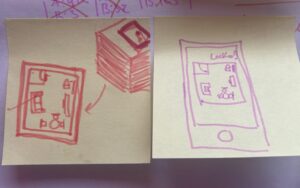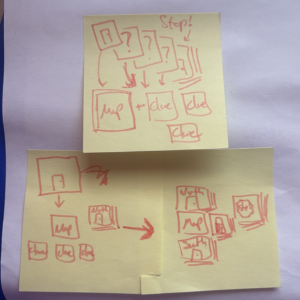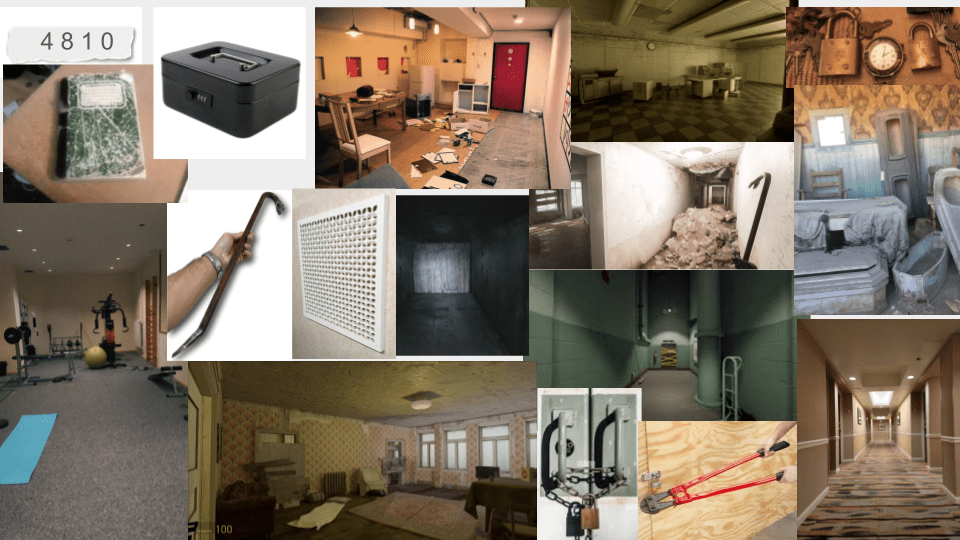My team is planning to make an app-driven card game, featuring escape-room-esque puzzles that see the player descending through the floors of an abandoned hotel.
Emotions:
- Intrigue – Players should be wondering about something the entire game. The game should leave the players with questions that motivate them to keep playing, like a good book you can’t put down.
- Unease – The game should feel eerie, creepy, spooky, etc, but not scary, terrifying, or horrifying. My team is considering making a physical game, and I feel like horror is more difficult to pull off in a physical game without the entire experience falling flat. I think we will be more successful if we try for eeriness than if we try for horror.
- Camaraderie (with “Buddy”) – We plan on having a single NPC that the player depends on the entire game, who betrays the player at the very end. To make this twist as impactful as possible, the player should feel close to this NPC. However, we will need to balance this against our goal of creating unease in the player.
Possible Directions:
There are three major game elements I’ve been considering: clues, maps and communication with Buddy. I’ve been brainstorming ways of distributing these elements between a mobile device and a deck of cards. After some consideration, the interactive potential of a mobile device seems better suited for communicating with Buddy, so I tried fleshing out some ideas for splitting the map and clues between cards and a mobile device. Each of the concepts has tradeoffs, so I predict we’ll end up with some combination that brings out the best in all of these formats.

1. Map on cards, Clues on phone. This option would entail creating digital maps of locations as well as physical cards with location maps on them. The app-driven board game Mansions of Madness works like this. Players could inspect details of the room on their phone, completing puzzles to unlock doors. When a new door unlocks, the game could instruct the player which map card to place, such that the player is building out a map of the space by placing cards next to each other. This would also allow for more interesting interactive puzzles than static cards could e.g. match-three, sliding blocks, cracking a safe, etc. This version of our game would allow us to tell a story through puzzle-solving, so we would need to come up with a variety of puzzle concepts and find ways to communicate narrative information through the puzzles e.g. reassembling an old family photo. The problem with this is that the cards and the app would be redundant. The map cards would not add anything to the experience not already captured by the app.

2. Clues on cards, Map on phone. This option would have players drawing cards to reveal clues e.g, old photos, mail, etc. and using them to solve puzzles e.g. finding a combination for a locked box. I think this option is more cohesive than option (1), as the tactile element of holding physical clues is more immersive than viewing digital clues. This version of the game implies communicating puzzles through story, rather than story through puzzles. By this I mean that puzzles in this version might skew toward finding important information in documents and using that to crack combination locks, find secret doors, etc. The story would then be communicated more in writing than in visuals or in interaction.

3. Map and Clues on cards. This concept interests me the most. Players would have a stack of both clue cards and map cards. As the players discover doors, they lay out map cards with clue cards stacked underneath. Then, once they’re able to open a locked door, they reveal the map card and all of its associated clue cards. In this case, the player’s mobile device principally allows them to talk to Buddy. I like that this format would streamline a player’s interactions with their mobile device so that it’s only used for one purpose. I think this makes the game more immersive and easier to learn. Furthermore, it gives us the opportunity to create anticipation and excitement for the player. They’ll be able to see that there are clues hidden behind each door, so opening a door will feel exciting. I think this format will have us revealing most of the story through both clues and dialogue with Buddy, so it similarly implies a narrative communicated principally through writing. The drawback is that this format limits our ability to create interactive puzzles.




